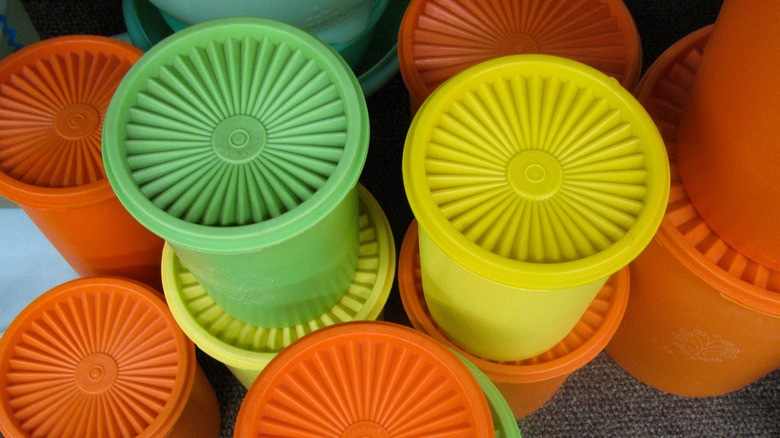Why You Should Stop Using Those Vintage Plastic Food Containers From Your Grandma
We may receive a commission on purchases made from links.
Have you ever stumbled upon a stash of vintage 1970s plastic containers, or inherited a load of them from your grandma? The brightly colored containers with snappy lids are a charming part of kitchen nostalgia, as are the famous Tupperware parties of yesteryear. Perhaps issues of food safety with these collectible pieces has never occurred to you — but unfortunately, it's something to consider. By today's standards, they can actually be harmful to the food and health status of your entire household.
Most older plastic food containers contain BPA (Bisphenol A), a chemical commonly used in hard, clear plastics. FDA regulators originally approved BPA for food-contact as far back as the 1960s, long before BPA was identified as a potential endocrine disrupter, which contributes to negative brain effects, hormone development, and other health concerns. In 2014, the FDA advised against BPA for use in baby bottles and sippy cups, but Tupperware had already removed it from its products by 2010.
This, sadly, means that pieces manufactured before that year should be retired from active use. Even if the pieces look fine and have no obvious cracks, scratches, or discoloration, they can still be dangerous, as older Tupperware likely saw a lot of consistent use, potentially causing micro-cracks. Sunlight from picnics, plus exposure to heated or acidic foods, could cause plastic polymers to break down, making it easier for BPA to leach into foods even years later. And it's not just BPA; others serious contaminants in Tupperware have come to light in recent years.
What else lurks inside that beloved vintage Tupperware
Though Tupperware is a popular vintage thrift-store find, the company is actually still producing food containers, despite bankruptcy proceedings and subsequent new owners in 2024. Though BPA got booted out of its products in 2010, many of the still-circulating original containers harbor other harmful substances that shouldn't come into contact with food, including lead, cadmium, arsenic, and mercury.
Consumer goods advocate Tamara Rubin, known as Lead Safe Mama, conducted tests on vintage Tupperware in recent years, starting with the popular Daffodil Yellow vintage measuring cups from the 1970s. Using XRF testing, she discovered lead in the cups as well as arsenic, a discovery she didn't foresee. Testing on other pieces revealed cadmium and arsenic, bringing Ruben to conclude that, considering heavy regular use and multiple toxicants, "There is no defensible reason to save items like this and use them for food use purposes."
Modern Tupperware is still made with plastic, but per the company website, all products sold by Tupperware U.S. and C.A. are made of BPA-free materials. The company's food-storage containers, mixing bowls, and serveware are still bright, colorful, and useful on many levels. But are the designs as cool as ones from the retro '70s? You can be the judge of that. If you really want those throwback designs as kitchen workhorses today, check out the Tupperware Heritage Collection on Amazon, which re-creates that vintage flair, including classic starburst lids — sans the BPA. That said, you still may want to consider using glass storage containers instead of plastic.

